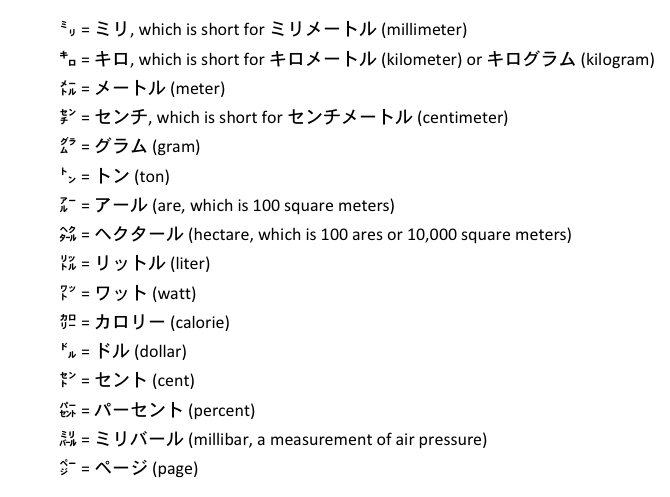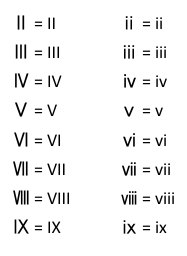Indivisible Characters
While investigating units of measurement in essay 1973 on 瓦, I came upon an odd-looking stack of katakana: ㌕. My puzzlement led to an investigation that widened to include a range of indivisible characters.
㌕ and ㎏
As I learned, ㌕ is an alternate way of writing キログラム (kilogram), which sprawls across the page in a way that's anathema to newspaper publishers. To save space, the Japanese have devised a method of typing concise things such as ㌕. If you want to reproduce this character, type きろぐらむ and press the space bar to bring up various conversion options.
Another example is "㎏." This is one, indivisible character. There's no way to place a cursor between the two letters in this character (which you can again produce using the method I just explained). That lack of interstitial space differentiates "㎏" from "kg," written with two keystrokes.
Parentheses That You Can't Detach from Kanji
In the next example, ㈱, it's not just the components that have an unbreakable bond. Even the parentheses are part of the character. Here's what that character means:

The character ㈱ differs from (株) because I can delete the parentheses in (株) if I want. By the way, to type ㈱ I went to Microsoft Word's menu bar, Iooked under "Insert," chose "Symbol," changed the font to Osaka, and then scanned the tiny options until I saw what I wanted.
The parentheses in both ㈱ and (株) mean that 株式会社 (which is part of a legally registered company name and indicates the company's legal status) has been abbreviated. That is, when referring to 東京電力 (とうきょうでんりょく: Tokyo Electric Power Company), you can't write it as 東京電力株. In informal contexts, you would use 東京電力(株), and in formal contexts you would write 東京電力株式会社.

Photo Credit: Kayoko Kurimoto
The first black character, ㈱, is the indivisible abbreviation for 株式会社
(かぶしきがいしゃ: joint stock company). At the top, in red, we see the name of the company, 雪の花みそ (ゆきのはなみそ: Snow Flower Miso), In the longer column of black kanji, we find this:
杉田 (すぎた: family name)
味噌 (みそ: miso)
醸造場 (じょうぞうじょう: brewery)
This, then, is the Sugita Miso Brewery. Finally we see this:
三和 (さんわ: place in Niigata Prefecture)
工場 (こうじょう: factory)
Two more indivisible characters also include parentheses, again indicating abbreviated expressions. One character is similar to ㈱, in that it relates to corporate structure:

People can no longer establish limited liability companies in Japan, as this type of company structure was abolished in 2006.
Here's the other parenthetical compression:

This indivisible kanji, along with its stretched-out versions, represents the phone number of a company's receptionist. The symbol goes at the end of a phone number, as in this example: 03-1234-5678 ㈹.

Photo Credit: Lutlam
This photo from Akihabara (a section of Tokyo) contains three indivisible characters! In the upper sign, we have 田中無線電機㈱:
田中 (たなか)
無線 (むせん: wireless)
電機 (でんき: electrical)
In other words, the company name is Tanaka Wireless Electric Appliances Co., Ltd. Here again we see ㈱, but this time it comes at the end of the company name. The 株式会社 can come at the beginning or end of the company name; the placement has no particular significance. Company names starting with 株式会社 are known as 前株 (まえかぶ), and company names ending with it are 後ろ株 (うしろかぶ) or 後株 (あとかぶ). Next we have a phone number that ends in ㈹. Finally, the name of another company appears in the lower left sign: 瀬田無線㈱. Here, 瀬田 (せた) is a family name. You know 無線. The company deals with electrical appliances, such as cables, switches, and other electrical parts.
Compressed Names of Japanese Eras
Four more compressed characters represent the most recent Japanese era names:

I wouldn't have thought it necessary to smush these two-kanji compounds into solitary characters, which are so busy as to be almost illegible. However, the sheer frequency with which people use them must have made this desirable.
More Stacks of Katakana
Now we come upon more katakana concoctions:


Photo Credit: Lutlam
The symbol at the beginning of this sign tells us that Miyajima (宮嶋, みやじま) Motors was a limited liability company prior to 2006. That company structure no longer exists, but companies set up in that way before 2006 were not required to change their names or to post new signs once the rules changed.
Indivisible Romanized Abbreviations
As if all those metric measurements weren't enough, you can also write some of them this way, with indivisible forms on the left:

A few more compressed forms also include roman letters:

Let's switch from roman letters to roman numerals:

Oddly, the compressed versions of those numerals (on the left sides of both columns) are much taller than their uncompressed counterparts! By the way, the "compressed" numerals Ⅰ, ⅰ, Ⅹ, and ⅹ also exist, but there's no real reason to write these solitary characters in a more concise way, except to be consistent with other compressed characters nearby on the page.
The Japanese Term for Compressed Characters
As for what the Japanese call these sorts of smushed-together characters, here's the relevant term:
組文字 or 組み文字 (くみもじ) combination + characters (last 2 kanji)
You can find more examples of 組文字 (as well as the corresponding Unicode character codes) at Wikipedia.
One Condensed Thought
This Thematic Exploration about compressed expressions turned out to be rather long. Perhaps I should have written it all with condensed characters!
